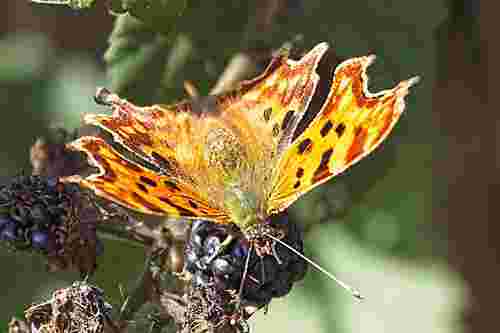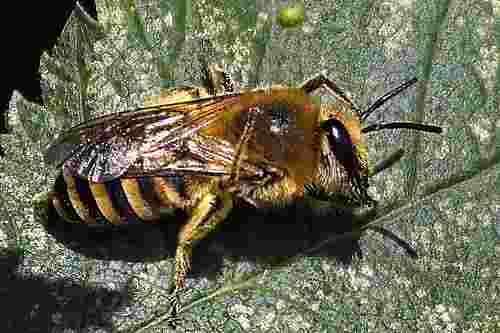Leader: Rob Randall
Warm sunny weather ensured that there were plenty of insects on the wing. The first encountered was a large colony of Ivy Bees (Colletes hederae) flying furiously over their burrows. They are not social insects but do live in large colonies, each female with her own burrow. The nest-site was an earthen bank on Haycombe Lane where it is crossed by Washpool Lane. The latter is an old pack road from Englishcombe to Twerton. Of the butterflies seen, Speckled Woods were almost everywhere as were Small Whites. A few freshly emerged Red Admirals were encountered as well as a very brightly coloured Comma.
 Comma © David Hall
Comma © David Hall
 Ivy Bee © David Hall
Ivy Bee © David Hall
The party descended to the ‘washpool’, a ford where the track crosses Padleigh Brook, then along a footpath beside the brook, through a pasture that had lain derelict for many years, but recently had experienced regular grazing. This and a number of other pastures near Englishcombe have good colonies of Devil’s-bit, so could be important locations if the Marsh Fritillary makes a comeback.
Further down, the path was crossed by a track which passes through a rather architectural avenue of Hornbeams. Eventually the path joined Haycombe Lane. The brook used to be crossed there on foot by stepping stones but these have sadly been discarded and replaced by a concrete slab. Further on the track crosses Newton Brook over an old bridge, ‘The Estate Bridge’ on the boundary of Newton St. Loe. The party continued a short distance on that side of the brook to a point where the Wansdyke can be clearly seen in a field opposite. They then returned and walked through the fields to Englishcombe. On the way a small toadstool, probably a Dung Roundhead, was examined and a springtail was discovered hanging on under the cap. It was one of the chunky species in the family Sminthuridae. Near the church there was a good colony of Giant Puffballs (Calvatia gigantea) by the village pond, which had been renovated as a millennium project but which was now neglected and under deep shade from the surrounding trees. After taking a short-cut through the churchyard, the group examined the tithe barn, which is surprising large considering the size of the village, but when in use it probably housed tithes from a much wider area.
The party returned to Haycombe via Washpool Lane but took a detour on a footpath that provides excellent views of Culverhay Castle. A bonus for the day was a Clouded Yellow spotted flying through the steep pastures above the path: the first one of the year for most of the party. Another extra on the way back was a patch of Field Garlic (Allium oleraceum), now in seed, in the hedgebank of Haycombe Lane. A relative of Crow Garlic (A.vineale), but rare locally and only known from a few hedge-banks south of the city.
Rob Randall


Recent Comments